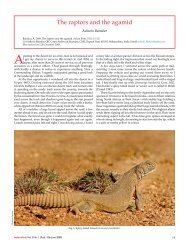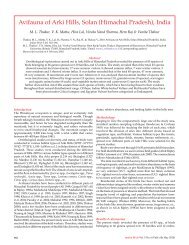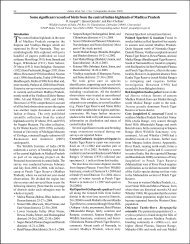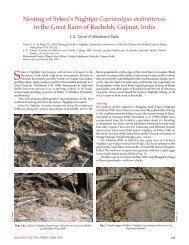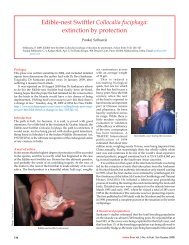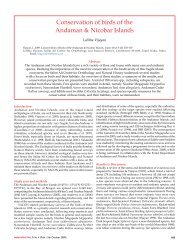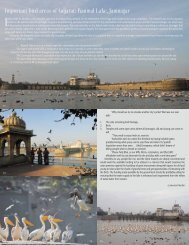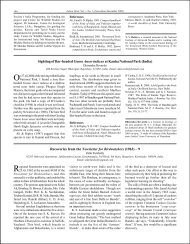Black-necked Crane Grus nigricollis (Local Name ... - Indian Birds
Black-necked Crane Grus nigricollis (Local Name ... - Indian Birds
Black-necked Crane Grus nigricollis (Local Name ... - Indian Birds
- No tags were found...
Create successful ePaper yourself
Turn your PDF publications into a flip-book with our unique Google optimized e-Paper software.
<strong>Indian</strong> <strong>Birds</strong> Vol. 1 No. 5 (September-October 2005) 111Hill Pigeon Columbia rupestris (<strong>Local</strong> <strong>Name</strong>: Angoa, Mukron)We found this bold bird almost everywhere that we traveled in Ladakh, atLeh, Mahe, Hanle, Tso-moriri and Tso-kar. Also at the Shey and Tiksemarshes. They fed on gravel and also near restaurants. On the highways atLeh they were seen feeding on left over food. They look bulky and verysturdy to survive the harsh climatic conditions of Ladakh. Their survivalskill were great and we found them feeding on seeds and partially digestededibles from the dung of kiang. We even found them feeding on theundigested food from the stomachs of dead kiangs at Hanle, which wereripped open by local dogs and birds of prey.Little Owl Athena noctua (<strong>Local</strong> <strong>Name</strong>: Ugpa)At Tso-kar, a pair had nested inside a wolf-trap. These are designed byPashmina tribals to trap and kill wolves, which prey on their Pashminagoats. There were four fully grown chicks, which never allowed us tophotograph them; they hid themselves well inside the stony construction ofthe wolf trap. Tso-kar did not have much water, as we expected, but hadlots of voles, which are part of the owl’s prey. The adult sat under theshade of a boulder and allowed us to take a few pictures. The sun light wasvery harsh for photography and we left the area happy with the knowledgethat the pair had bred successfully and the young were in good condition.Horned Lark Eremophila alpestris (Loal <strong>Name</strong>: Rizit)Horned Larks are among the commonest birds in Ladakh. We found them veryactive even after sunset. At Tso-moriri, where there is enough sunlight even at20:00hrs, these birds fed on grass seeds and tubers even as late as 22:00hrs. Theirfledged young (top photo) are beautifully marked in buff, black and brown on theback. July being almost the end of their breeding season, we found manyjuveniles flying around adults and feeding on grass seeds and tubers. They wereeven digging for maggots in the marshes. (Middle: Female. Bottom: Male.)



